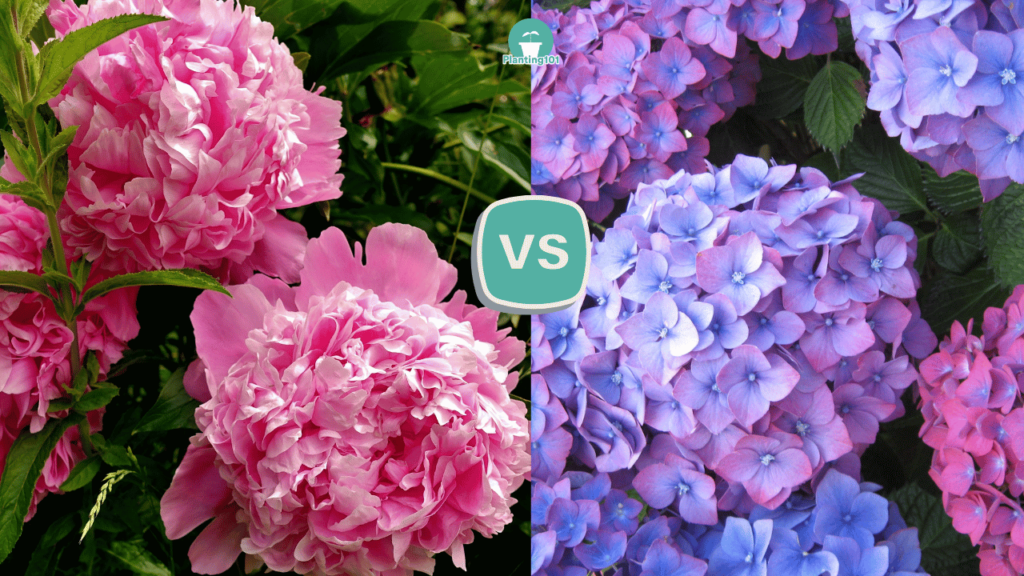Are you wondering if you should plant peonies or hydrangeas in your garden? As a gardener with over 20 years of experience planting both hydrangeas and peonies, I can give you the pros and cons of both hydrangeas and peonies and give you some recommendations on which plant to choose.
Peonies vs Hydrangeas
Peonies vs Hydrangeas Bloom Time
Peonies and hydrangeas have different bloom times. Peonies bloom from late spring to early summer. They typically have a relatively short but intense bloom period.
I love when I see peony flowers burst into color in late spring to early summer, giving my garden a stunning display for a few weeks!
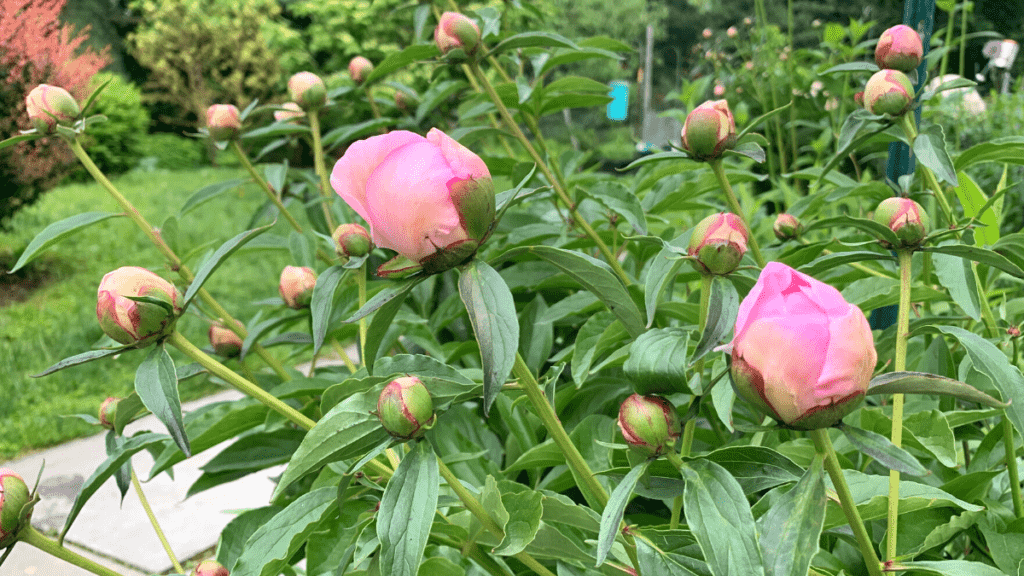
The exact bloom time can vary depending on the peony variety and your USDA plant hardiness zone.
Compared to Peonies, Hydrangeas have a longer bloom time. Some hydrangeas start blooming as early as late spring or early summer, while others may flower from mid to late summer or even into early fall. This extended blooming period allows you to enjoy your hydrangeas longer!
One advantage of planting both peonies and hydrangeas is that their bloom times overlap, so you will have continuous flowers in your garden.
As peonies begin to fade, hydrangeas start to take center stage, ensuring a seamless transition of color in your garden. By planting both peonies and hydrangeas, you can create continuous floral interest and keep your garden vibrant throughout the summer season.
Peonies vs Hydrangeas Light Requirements
When it comes to light requirements, peonies and hydrangeas have slightly different preferences. Peonies grow best in full sun. They will also thrive in partially shaded areas, with at least six hours of direct sunlight each day.
Although Peonies are happiest when they are in full sun- you will get more peony flowers when exposed to plenty of sunlight.
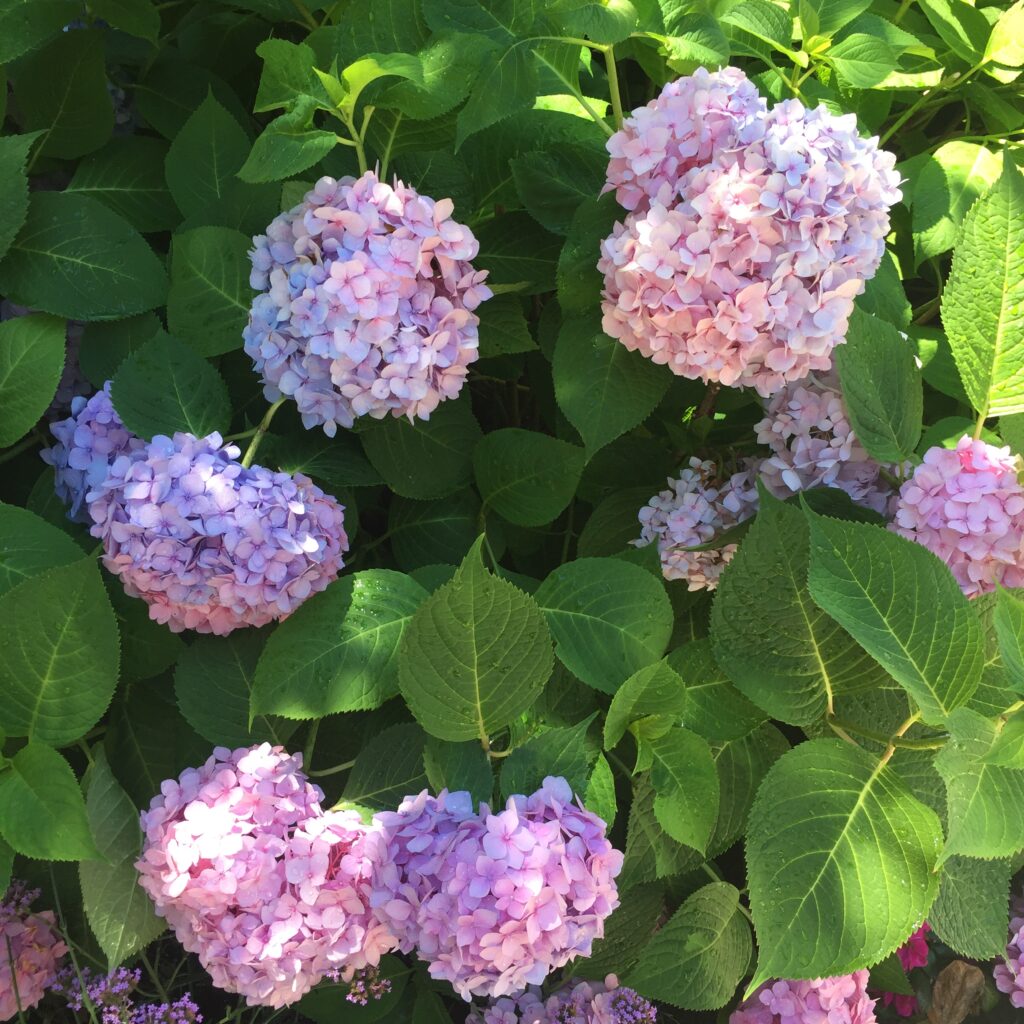
On the other hand, compared to peonies, hydrangeas prefer more shade. Hydrangeas grow best in a mix of sun and shade- half day of sun with either morning sun or just afternoon sun.
While hydrangeas can tolerate full sun, it’s going to be a lot harder to keep your hydrangeas happy when it’s planted in full sun. Your hydrangeas will wilt if planted in full sun and you will have to give it plenty of water to revive it.
So what should you plant in your garden? It depends, if you have a partial shade location then I suggest planting hydrangeas there. While if you have a full sun location in your garden then I suggest planting peonies.
Peonies vs Hydrangeas Watering Requirements
Both peonies and hydrangeas have similar watering requirements. If you have established peonies and hydrangeas in your garden, you really don’t need to water it that much.
I personally, water my peonies and hydrangeas once a week and they do just fine. And when I go on vacation or I get too busy and end up skipping a week or two of watering, no problem! They will survive.
Of course, if there is a heatwave, then you should increase watering frequency. And if your hydrangeas are planted in full sun, then you should water them daily.
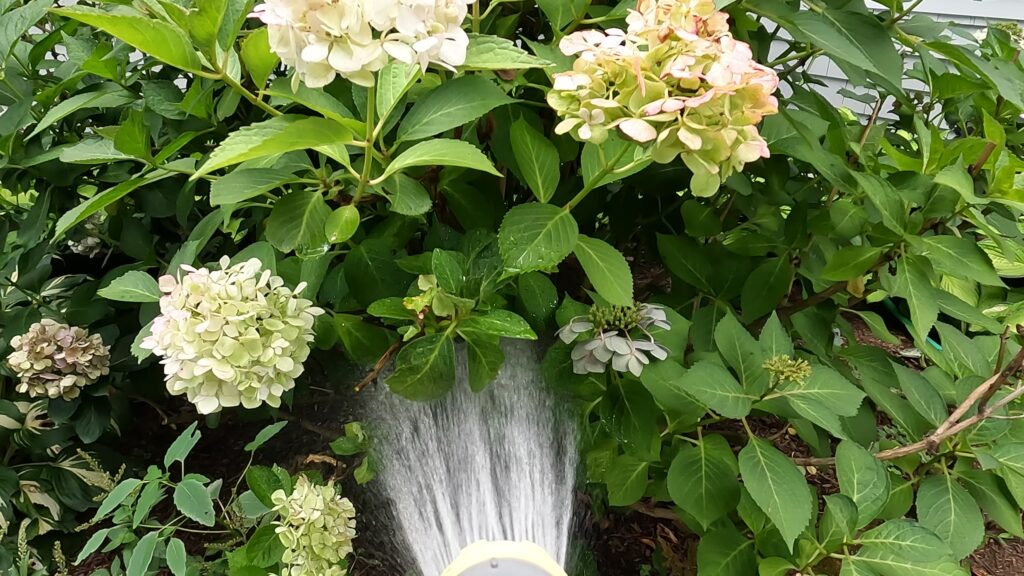
So if you are looking for a low maintenance plant that requires minimal watering care, then you can’t go wrong with either peonies or hydrangeas. Both hydrangeas and peonies have very similar watering requirements.
Peonies vs Hydrangeas Soil Requirements
Peonies and hydrangeas have similar soil preferences. Both Peonies and hydrangeas grow best in well-draining soil enriched with organic matter.
The pH requirement for both plants varies slightly. A pH level slightly on the alkaline side (around 6.5 to 7.5) is ideal for peonies to maximize their growth and flowering potential.
Hydrangeas, on the other hand, prefer a slightly acidic to neutral soil with good drainage. Hydrangea flower color can also be influenced by soil pH, with blue blooms appearing in more acidic soils and pink blooms in alkaline soils.
Honestly, don’t go crazy measuring the pH of your garden soil. Both peonies and hydrangeas are both tolerant and will grow well in any garden soil. Probably more important is to make sure the soil is well-draining.
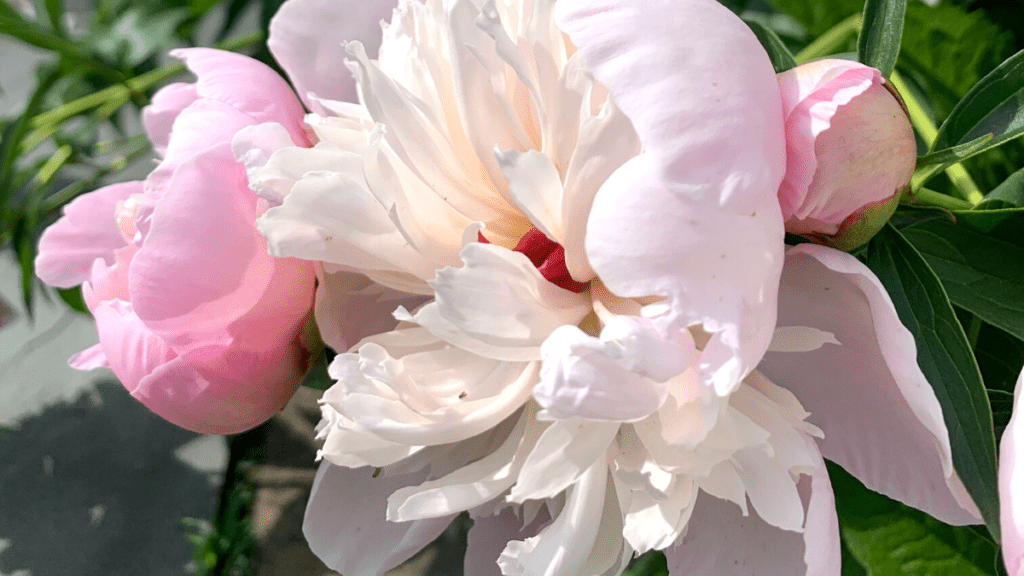
Peonies vs Hydrangeas Maintenance Care Requirements
Both peonies and hydrangeas are low maintenance plants. You really don’t have to do much and they will come back, year after year!
The once-a-week watering is really all they need and I usually feed it fertilizer once a year. That’s it!
The only additional maintenance I do to my hydrangeas is I do clean it up during late winter by removing dead branches. I don’t prune. But it’s really optional and if you don’t, it’s not a problem. Your hydrangeas will come back the following year as beautiful as ever!
And the only additional maintenance that I do to my peonies is adding garden stakes to support the heavy peony flower heads since they have a tendency to topple over. It takes me 5 minutes to add these garden stakes every year- so easy! And in the late Fal, during my garden’s fall cleanup, I do cut down my peonies.
So if you are deciding whether to plant peonies vs hydrangeas based on which one of lower maintenance, they both are equally low maintenance.
Peonies vs Hydrangeas Cut Flowers
Peonies and hydrangeas both make beautiful cut flowers. Peonies have large, showy blooms and are best cut when the buds are soft but not fully open. Peonies cut flowers are long-lasting, typically lasting around 5 to 7 days in a vase.
Hydrangeas are also long lasting cut flowers. They can last a week.
Both peonies and hydrangeas are beautiful cut flowers. I love that the bloom times are different for both peonies and hydrangeas.
In early summer, I will decorate with cut peonies while in late summer, I fill my vases with cut hydrangeas! The different bloom times allow me to continuously decorate with fresh blooms throughout the season.
Peonies vs Hydrangeas Deer Resistance
If you’re worried about deer munching on your beloved peonies or hydrangeas, I have some reassuring news for you. In my experience, deer tend to steer clear of both peonies and hydrangeas, making them a safe choice for gardens prone to deer.
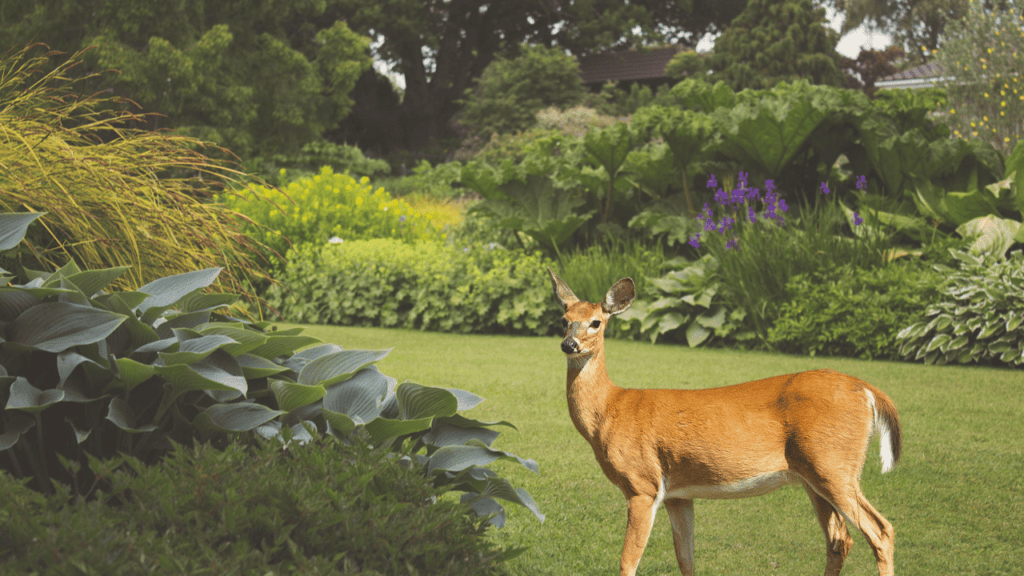
From personal experience, I have found that deer typically pass by peonies and hydrangeas without so much as a nibble. Both peonies and hydrangeas seem to be low on their list of preferred snacks.
If you’ve struggled with deer damaging your garden, you can take solace in the fact that both peonies and hydrangeas are unlikely to attract their attention. You can grow peonies and hydrangeas in your garden without worrying about deer feasting on them.
So, whether you choose peonies or hydrangeas for your garden, deer are unlikely to make a meal out of them. I find that deer will gravitate toward other plants and will leave hydrangeas and peonies untouched!
Check out my blog post about Deer and Hydrangeas
Final Thoughts on Whether to Plant Hydrangeas vs Peonies
When it comes to choosing between hydrangeas and peonies for your garden, you really can’t go wrong with either plant. Both of these perennial flowering shrubs will look great in any garden and the best part is they are both low maintenance plants.
The main consideration would be the light requirements since peonies prefer sunny locations while hydrangeas thrive in more shaded areas. So depending on the light condition in your garden, this will probably influence your decision.
If you have room in your garden, I suggest planting both hydrangeas and peonies. I personally have both peonies and hydrangeas in my garden. They are beautiful flowering plants and the bloom time complements each other because peonies will bloom first and then hydrangeas will come after.
By planting both peonies and hydrangeas you can enjoy a continuous display of blooms in your garden throughout the season!
You May Also be Interested in these Hydrangea Care Tips
Step by Step: How to Easily Propagate Hydrangeas (video)
How to Deadhead Hydrangeas (video)
How to Make Hydrangeas Flower (video)
Beginner’s Guide: How to Care for your Hydrangea (video)

